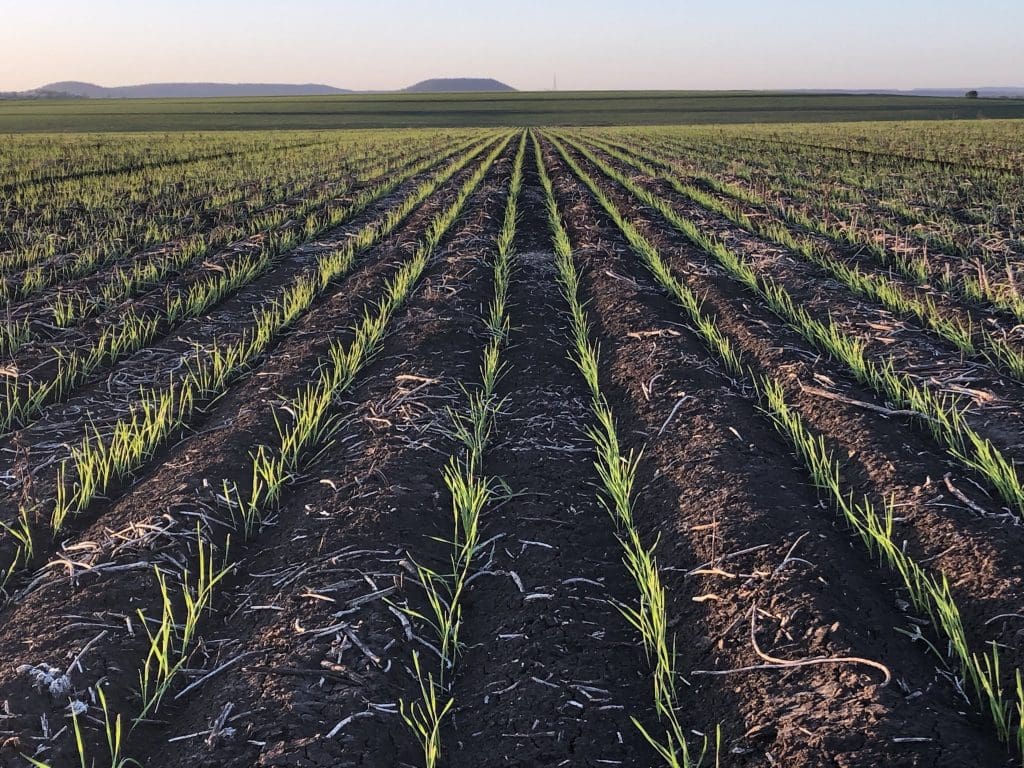
This Sunrise wheat crop at Gurley is one of many in northern NSW which is off to a flying start. Photo: Tony Lockrey, AMPS
THE SEEDING window for this season’s Australian winter-crop is now wide open, and growers are sowing around the clock in many regions. Those growers who have had good autumn rains are taking advantage of the ideal soil moisture and soil-temperature conditions, an indulgence many have not experienced for up to four years.
New South Wales
The turnaround in the soil moisture profile in New South Wales has been phenomenal. Almost all of its cropping districts have had more than 150 per cent of average rainfall for the three months ending April 30. Most farms in the more marginal areas west of the Newell Highway have received more than double their average for the same period.
This is excellent news for farmers in the drought-ravaged central-western and north-western areas, many of whom have grown very little grain since the bumper harvest in 2016. These are the big swing areas of the state, and when they get a good start, production can be huge. With a good moisture profile at the ideal time sowing time, there will be a massive increase in the state’s planted area, and near-record production is a possibility if the season is kind.
A NSW wheat crop approaching 9 million tonnes (Mt) is undoubtedly on the cards, especially with the positive three-month rainfall outlook issued by the Bureau of Meteorology (BOM) last week. Barley production in excess of 2Mt, canola production of 1Mt and chickpea production of 400,000t are realistic expectations at this early stage in the crop calendar.
Victoria
Victoria is in a very similar situation. The northern parts of the state suffered dreadfully from a poor spring in 2019. They have received upwards of 150pc of their average rainfall for the February-to-April period. Conversely, south-western parts of the state, which had a cracking 2019 crop, have not fared as well, but are still above average.
With the great start to the planting season, production of 4Mt of wheat, 1.9Mt of barley and 700,000t of canola is quite achievable in Victoria, assuming at least average monthly rainfall for the balance of the season.
South Australia
Rainfall in the second half of April has been sufficient to raise the soil-moisture profile in most of South Australia’s winter-cropping regions to very favourable levels as the planting of this year’s crop moves into top gear. With soil temperatures still relatively high for this time of year, early sown crops are absolutely jumping out of the ground.
As a result, winter-crop production is expected to jump significantly on the back of an increase in planted area and improved yields. A wheat crop of 4.5Mt, barley crop of 1.8Mt and a canola crop of 0.4Mt are credible targets at this point in the season.
Queensland
The two states that still have big question marks regarding 2020/21 production are Western Australia and Queensland, both due to lack of autumn rainfall.
The weather pattern in southern Queensland so far in 2020 is eerily similar to that of last year, except for rains which came in late summer being about two weeks earlier. And like the autumn of 2019, the tap has been turned off, and confidence around winter-crop production is waning. Many parts of central Queensland are in the same boat, with wet-season rainfall well below average.
It is still early in the planting window, and there is plenty of time for rain to arrive. A certain proportion of the crop will be sown dry but on the back of three poor winter crops in a row, and very little joy from a summer-crop viewpoint over the same period, the appetite for growers to go all-in is simply not there. The risk is far too high until there is evidence that the weather pattern has changed.
At this stage of the cycle, a wheat crop of 1.8Mt, barley production of 300,000t and chickpea output approaching 400,000t is possible, but more autumn rain is required across all districts to maximise the Queensland plant.
Western Australia
Year-to-date rainfall in Western Australia is also below average across almost all districts. Unlike eastern Australia, save for Queensland, April rainfall was no more than 40pc of average in most regions. That said, the average autumn break for the state is 25 May, so it is definitely not panic stations yet.
While a poor production year in the west in 2019 may be fresh in growers’ minds, most are now focused on planting their 2020 crop, whether it be into moisture, or in most cases, dry. Assuming the break arrives in the second half of May a return to above-average yields is expected. Wheat, barley and canola production of 10.5Mt, 4Mt and 1.7Mt respectively appear reasonable opening estimates.
Wheat biggest winner nationally
With the excellent planting conditions through NSW, Victoria and South Australia, and plenty of time for the Western Australian cropping belt to receive its autumn break, national winter-crop production is in for a sizeable rebound compared with last season.
Wheat will be the biggest winner with a 28Mt crop, up 93pc from the 14.5Mt produced in 2019. The increase in barley production will not be as dramatic, mainly because the crop held up exceptionally well under adverse production conditions last year. A crop of 10Mt is undoubtedly achievable, up from 8.5Mt last season. Canola and chickpea production should both increase year-on-year to 3.8Mt and 800,000t respectively.
The BOM is forecasting wetter-than-average conditions across the southern two-thirds of the continent for the May-to-July period and a possible negative Indian Ocean dipole in the second half of the year. This favours Australia’s winter-cropping regions, and augurs well for a return to average or above-average production. However, the one state that remains a concern at the moment is Queensland, especially as it is now entering its dry season.
Grain Central: Get our free daily cropping news straight to your inbox – Click here

HAVE YOUR SAY